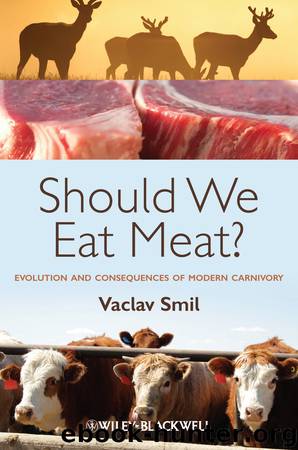Should We Eat Meat Evolution and Consequences of Modern Carnivory by Vaclav Smil

Author:Vaclav Smil [Smil, Vaclav]
Language: eng
Format: epub
ISBN: 9781118278697
Publisher: Wiley
Published: 2018-10-29T00:00:00+00:00
Animal feedstuffs
An overwhelming majority of feed consumed by livestock in 1900 was, as it has been for millennia, fed to draft animals, that is, to oxen, donkeys, water buffaloes and camels in poorer regions of the Old World and Latin America and to horses in richer parts of Europe and throughout North America (where mules were also important). In North America, production of this feed made an unprecedented claim on agricultural resources because abundant farmland made it easy to support large horse teams (on Midwestern farms and especially on the Great Plains and in California) and because draft horses were the domestic animals that received most often supplementary grain rations. At the beginning of the 20th century, working animals in the US were fed daily at least 4 kg of hay and 4 kg of grain (mostly oats or corn), while other horses received 2 kg of grain (Bailey 1908). When they reached their peak numbers during the second decade of the 20th century, America’s draft horses and mules required (assuming average grain yields of 1.5 t/ha and hay yields of at least 3 t/ha) at least 30 Mha, or a quarter of the country’s farmland, to secure their feed (Smil 1994).
Beef came from grass-fed animals, and while herds of cattle and flocks of sheep feeding solely on cellulosic phytomass on pastures were sometimes kept in densities above the sustainable capacity of the exploited grasslands and hence had considerable negative environmental impacts – no matter if poorly managed or carefully tended – they did not consume phytomass digestible by humans and did not pre-empt any potential food production; nor did pigs that were fed household waste or left to root for feed or brought to forage in forests, or the free-running poultry whose supplementary feeding consisted largely of small amounts of whole grain. In contrast, commercial success of modern meat production and the worldwide diffusion of CAFOs is predicated on reliable and relatively inexpensive supply of mixed (compound) feeds that are assembled entirely from domestic inputs or from ingredients imported from several continents and that can include a remarkable variety of phytomass and, not uncommonly, also processed animal matter.
Because of their balanced content of macro- and micronutrients, modern compound feeds are superior to traditional feeds (whole grains, milling residues or food processing wastes) that were generally too low in protein and whose composition often changed substantially as a surplus phytomass became available for feeding after harvests or as a by-product of crop processing of food preparation. Modern feeds should result in rapid weight gains while maintaining animals in good health; that the latter goal has been in some cases superseded by the former quest should be a matter of serious concern, and I will address it later in this chapter.
Compound feeds are produced for high-volume domestic and export sales by multinational companies, but they are also formulated in smaller, cooperative facilities for the use by individual farmers or prepared on site by the owners of large livestock feeding operations. Preparation
Download
This site does not store any files on its server. We only index and link to content provided by other sites. Please contact the content providers to delete copyright contents if any and email us, we'll remove relevant links or contents immediately.
Craft Beer for the Homebrewer by Michael Agnew(18194)
Marijuana Grower's Handbook by Ed Rosenthal(3640)
Barkskins by Annie Proulx(3334)
Project Animal Farm: An Accidental Journey into the Secret World of Farming and the Truth About Our Food by Sonia Faruqi(3189)
The Plant Messiah by Carlos Magdalena(2900)
Red Famine: Stalin's War on Ukraine by Anne Applebaum(2890)
0041152001443424520 .pdf by Unknown(2812)
Organic Mushroom Farming and Mycoremediation by Tradd Cotter(2660)
In the Woods by Tana French(2560)
Beer is proof God loves us by Charles W. Bamforth(2414)
7-14 Days by Noah Waters(2386)
Borders by unknow(2280)
Reservoir 13 by Jon McGregor(2264)
Meathooked by Marta Zaraska(2237)
The Art of Making Gelato by Morgan Morano(2233)
Between Two Fires by Christopher Buehlman(2217)
Birds, Beasts and Relatives by Gerald Durrell(2196)
The 7 Habits of Highly Effective People: Powerful Lessons in Personal Change (25th Anniversary Edition) by Covey Stephen R(2169)
The Lean Farm Guide to Growing Vegetables: More In-Depth Lean Techniques for Efficient Organic Production by Ben Hartman(2106)
